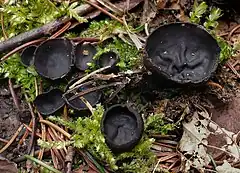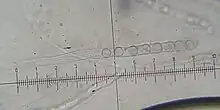| Pseudoplectania nigrella | |
|---|---|
 | |
| Scientific classification | |
| Domain: | Eukaryota |
| Kingdom: | Fungi |
| Division: | Ascomycota |
| Class: | Pezizomycetes |
| Order: | Pezizales |
| Family: | Sarcosomataceae |
| Genus: | Pseudoplectania |
| Species: | P. nigrella |
| Binomial name | |
| Pseudoplectania nigrella | |
| Synonyms[1] | |
|
Crouania nigrella (Pers.) Hazsl. | |
Pseudoplectania nigrella, commonly known as the ebony cup, the black false plectania, or the hairy black cup, is a species of fungus in the family Sarcosomataceae. The fruit bodies of this saprobic fungus are small blackish cups, typically up to 2 cm (0.8 in) broad, that grow in groups on soil, often amongst pine needles and short grass near coniferous trees. Pseudoplectania nigrella has a worldwide distribution, and has been found in North America, the Caribbean, Britain, Europe, India, Madagascar, New Zealand, and Japan. The fungus produces a unique chemical compound, plectasin, that has attracted research interest for its ability to inhibit the growth of the common human pathogenic bacterium Streptococcus pneumoniae.
Taxonomy and naming
Christian Hendrik Persoon named the species Peziza nigrella in his Systema Mycologia in 1801,[2] and it was sanctioned under this name in Elias Magnus Fries' Systema Mycologicum in 1821.[3] In 1870, German mycologist Fuckel transferred it to his newly described genus Pseudoplectania, and made it the type species.[4] The species was ulteriorly placed in Crouania by Friedrich August Hazslinszky von Hazslin, and in Plectania by Petter Karsten (1885), but neither placement is considered correct.[1]
The fungus is commonly known as the "ebony cup", the "black false plectania",[5] or the "hairy black cup".[6]
Description
The fruit bodies (technically called apothecia) typically grow in groups, or sometimes crowded closely together, with small stems or missing them entirely. Initially, the fruit bodies are closed and roughly spherical, but as they develop they expand to become cup-shaped, or almost flat. The inner surface of the cups bear the reproductive spore-bearing layer, or hymenium; it is brownish-black, with an edge that is often wavy and curved slightly inwards, and covered with fine hairs. The cups may reach up to 2 cm (0.8 in) in diameter.[7] The hairs are long but usually closely coiled and twisted, which gives to the exterior of the cup a slightly tomentose appearance of nearly uniform thickness throughout their entire length. They are pale brown and 4–6 µm in diameter.[8]

The asci are roughly cylindrical with a long stem-like base; the entire ascus is often as long as 300–325 µm and about 15 µm in diameter at the thickest point. The spores are round, smooth, translucent (hyaline), and have diameters of about 12–14 µm.[8] They are filled with many small oil droplets.[9] The paraphyses (sterile filamentous hyphae in the hymenium) are enlarged at their tips and filled with brown colored matter, about 4 µm thick.[8]
Similar species
Pseudoplectania sphagnophila resembles P. nigrella, but has a more deeply and persistently cup-shaped fruit body, a short but distinct stem, and only grows amongst sphagnum moss.[10] Plectania melastoma has elliptical to spindle-shaped spores measuring 20–28 by 8–12 µm, while Pseudoplectania milleri has elliptical spores, and the margin of its cups have star-shaped points.[11]
Edibility
Pseudoplectania nigrella is considered inedible. It has no distinctive taste or odor.[12]
Habitat and distribution
This species is saprobic, and is found growing in groups on the ground or on moss-covered decaying wood, especially amongst fallen pine needles.[10] In North America, fruit bodies appear in the spring and summer, and are fairly common;[9] in Britain, the fungus fruits from winter to spring, and is rare.[12] Its small size and dark color makes it easy to overlook.[13]
Pseudoplectania nigrella has a worldwide distribution, and has been found in North America, the Caribbean,[14] Europe, India, Madagascar, New Zealand,[7] Israel,[15] and Japan.[16]
Bioactive compounds

Defensins are antibiotics made from peptides and are typically found in animals and higher plants. Plectasin, found in Pseudoplectania nigrella, is the first defensin to be isolated from a fungus.[17] Plectasin has a chemical structure resembling defensins found in spiders, scorpions, dragonflies and mussels. In general, defensins have commonalities in their molecular structure, such as cysteines in the peptide stabilized with disulfide bonds. In particular, defensins from P. nigrella, invertebrates, and plants and share a conformation that has been named the CSαβ motif.[18] In laboratory tests, plectasin was especially active in inhibiting the growth of the common human pathogen Streptococcus pneumoniae, including strains resistant to conventional antibiotics. Plectasin has a low toxicity in mice, and cured them of peritonitis and pneumonia caused by S. pneumoniae as efficiently as vancomycin and penicillin, suggesting that it may have therapeutic potential.[17] In 2010, Chinese scientists announced a method for high-level production of plectasin using transgenic E. coli.[19]
References
- 1 2 "Pseudoplectania nigrella (Pers.) Fuckel 1870". MycoBank. International Mycological Association. Retrieved 2010-10-12.
- ↑ Persoon CH. (1801). Synopsis Methodica Fungorum (in Latin). Göttingen: Apud H. Dieterich. p. 648. Retrieved 2010-10-13.
- ↑ Fries EM. (1821). Systema Mycologicum (in Latin). Vol. 2. Lund: Ex officina Berlingiana. p. 81. Retrieved 2010-10-12.
- ↑ Fuckel L. (1870). "Symbolae mycologicae. Beiträge zur Kenntnis der rheinischen Pilze". Jahrbücher des Nassauischen Vereins für Naturkunde (in German). 23–24: 324.
- ↑ Tylutki EE. (1979). Mushrooms of Idaho and the Pacific Northwest. Vol I. Discomycetes. Moscow: University Press of Idaho. p. 28. ISBN 0-89301-062-6.
- ↑ Sundberg W, Bessette A (1987). Mushrooms: A Quick Reference Guide to Mushrooms of North America (Macmillan Field Guides). New York, NY: Collier Books. p. 4. ISBN 0-02-063690-3.
- 1 2 Paden JW. (1983). "Sarcosomataceae (Pezizales, Sarcoscyphineae)". Flora Neotropica. 37: 1–16.
- 1 2 3 Seaver, F. J (1913). "The genus Pseudoplectania". Mycologia. Mycological Society of America. 5 (6): 299–302. doi:10.2307/3753586. JSTOR 3753586.
- 1 2 Bessette A, Bessette AR, Fischer DW (1997). Mushrooms of Northeastern North America. Syracuse, NY: Syracuse University Press. pp. 495–96. ISBN 978-0-8156-0388-7. Retrieved 2010-10-13.
- 1 2 Dennis RWG. (1969). "Two new British Discomycetes with smooth spherical ascospores". Kew Bulletin. 23 (3): 479–81. doi:10.2307/4117192. JSTOR 4117192.
- ↑ Arora D. (1986). Mushrooms Demystified: a Comprehensive Guide to the Fleshy Fungi. Berkeley, CA: Ten Speed Press. p. 830. ISBN 0-89815-169-4. Retrieved 2010-10-12.
- 1 2 Jordan M. (2004). The Encyclopedia of Fungi of Britain and Europe. London: Frances Lincoln. p. 42. ISBN 0-7112-2378-5. Retrieved 2009-10-02.
- ↑ Ammirati J, Trudell S (2009). Mushrooms of the Pacific Northwest: Timber Press Field Guide (Timber Press Field Guides). Portland, OR: Timber Press. p. 293. ISBN 978-0-88192-935-5.
- ↑ Dennis RWG. (1954). "Operculate Discomycetes from Trinidad and Jamaica". Kew Bulletin. 9 (3): 417–21. doi:10.2307/4108810. JSTOR 4108810.
- ↑ Barseghyan GS, Wasser SP (2008). "Species diversity of operculate discomycetes in Israel". Israel Journal of Plant Sciences. 56 (4): 341–48. doi:10.1560/IJPS.56.4.341.
- ↑ Otani Y. (1980). "Sarcoscyphineae of Japan". Nippon Kingakukai Kaiho. 21 (2): 149–79.
- 1 2 Mygind PH, Fischer RL, Schnorr KM, Hansen MT, Sonksen CP, Ludvigsen S, Raventos D, Buskov S, Christensen B, De Maria L, Taboureau O, Yaver D, Elvig-Jorgensen SG, Sorensen MV, Christensen BE, Kjaerulff S, Frimodt-Moller N, Lehrer RI, Zasloff M, Kristensen HH (2005). "Plectasin is a peptide antibiotic with therapeutic potential from a saprophytic fungus". Nature. 437 (7061): 975–80. Bibcode:2005Natur.437..975M. doi:10.1038/nature04051. PMID 16222292. S2CID 4423851.
- ↑ Yamauchi H, Maehara N, Takanashi T, Nakashima T (2010). 微生物に対する生体防御分子としてのディフェンシン: 節足動物、軟体動物及び菌類に由来するディフェンシンの特性 [Defensins as host defense molecules against microbes: the characteristics of the defensins from arthropods, mollusks and fungi] (PDF). Bulletin of FFPRA (in Japanese and English). 1 (1). Retrieved 2010-10-13.
- ↑ Jing XL, Luo XG, Tian WJ, Lv LH, Jiang Y, Wang N, Zhang TC (2010). "High-level expression of the antimicrobial peptide plectasin in Escherichia coli". Current Microbiology. 61 (3): 197–202. doi:10.1007/s00284-010-9596-3. PMID 20165851. S2CID 24701934.